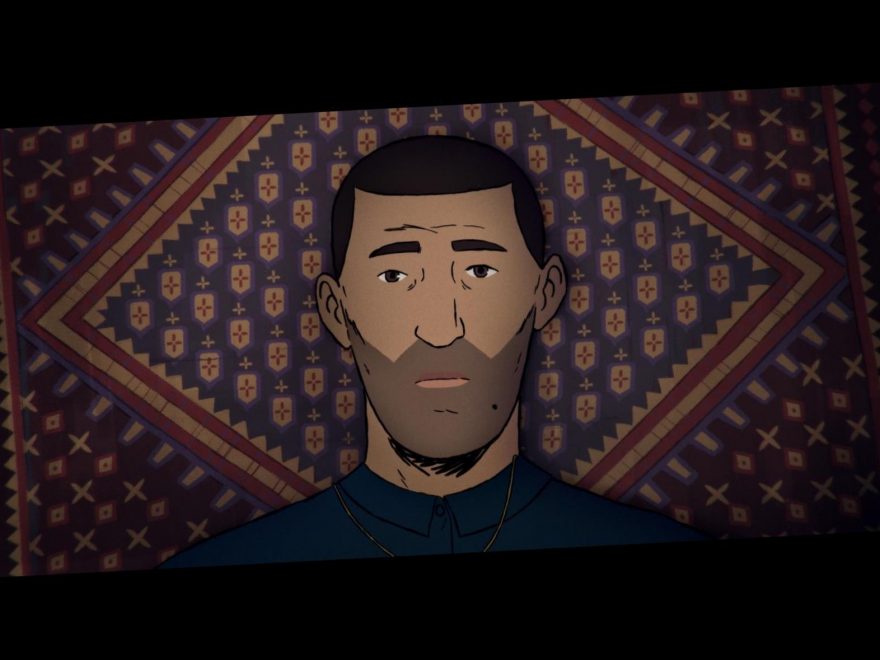There have been countless movies about the immigration crisis, but none of them have the sheer ingenuity of “Flee.” In Danish filmmaker Jonas Poher Rasmussen’s poignant animated documentary, an Afghan refugee recounts his 20-year survival story, and the dazzling storytelling goes there with him. Yet the remarkable graphic stye works in tandem with a narrative that would stun in any format: As the man — identified only by a pseudonym, Amin Nawabi — gradually opens up about his experiences, “Flee” builds to a powerful secret buried in his past that reframes the global migrant crisis in intimate terms.
From the moment Amin first appears, his bearded face rendered as a delicate 2D image, he’s wrestling with how to tell his story. Having fled the Middle East as an adolescent, Amin made his way with his mother and siblings first to Russia before finally settling in Denmark, where he now lives as an openly gay man with his partner. Amin’s survival is tied up in his sense of loss on many levels. Deprived of an innocent childhood or any semblance of stability as he entered young adulthood, he has repressed the bulk of his tumultuous journey for decades. “Flee” becomes his cinematic catharsis, as Amin recounts his journey in fits and starts, while the animation turns his memories into a bracing adventure that doubles as modern history.
Amin’s saga unfolds against the backdrop of constant turmoil. His Kabul childhood was defined by repeated threats to his family’s survival, abusive local authorities, and narrow border crossings (some more successful than others). His father was taken away by the Taliban when the Mujahideen took charge. His teen brother was nearly forced into the battlefield to confront U.S. troops in a bloody war. Yet somewhere in the midst of that chaos, “Flee” finds the material of a charming coming-of-age story, as the young Amin hides in a bedroom adorned with Western movie posters and develops a surreptitious crush on Jean Claude Van Damme.
On the verge of desperation, the family hops a flight to Moscow, where things don’t get much better. Hovering in a decrepit apartment and constantly harassed by corrupt police, Amin’s family slip from one oppressive regime to another. Amin makes for a compelling storyteller, even when he seems hesitant to reveal too many details, as the animation fills in the gaps and keeps the drama moving along. The result extends beyond the boundaries of traditional documentary reenactments to make Amin’s story more absorbing than his words ever could.
Despite the bright colors and expressions that lend a sophistication to the backdrops of these scenes, “Flee” takes full advantage of its pliable form, often to dizzying effect. During a harrowing ocean trip that finds Amin and his relatives packed inside a claustrophobic box in the middle of a rickety vessel, the images devolve into black-and-white abstraction, echoing the profound disorientation as Amin recalls his fears in precise detail. The gut-punch outcome of that sequence adds to the constant impression that Amin has been beaten down so many times it’s a wonder he has any semblance of humanity left.
But, of course, he’s not alone in his struggles. Contemporary footage (also animated) offers glimpses of life with his supportive boyfriend Kasper, who hopes to find a home for the two of them in the countryside. While Kasper encourages Amin to accept the idea that they can settle into the next stage of their lives, but the trauma of the past keeps holding him back. His conversations with Rasmussen, and “Flee” as a whole, take on a striking cathartic power as they build to the final chapter of Amin’s story and the unnerving lie that allowed him to finally resettle in a welcoming society. When the movie gets there, Rasmussen sounds as shocked as we are to hear the details. In some contexts, the appearance of the filmmaker in the middle of someone else’s story might seem like a distraction; here, he’s essentially an avatar for the audience, allowing them to feel the personal ramifications of Amin’s saga even as his true identity remains a secret.
“Flee” is not unprecedented in its approach. Ari Folman’s remarkable “Waltz with Bashir” applied a similar approach to resurrecting wartime memories and rendering them in vivid detail. In that case, Folman actually managed to craft a sophisticated war movie out of talking head recollections. “Flee,” however, could easily have been made in more traditional terms, if its subject had allowed himself to appear on camera. But Rasmussen has devised a clever means of allowing his subject to maintain his secrecy — for reasons that become obvious as the story goes on — while enabling the essence of his struggle to coalesce into a rousing singular vision. It’s activism, therapy, and great cinema all at once.
Rasmussen has explored shocking weird-but-true stories before (his last documentary, “What He Did,” tracks a psychologist and celebrated author who murdered his lover). With “Flee,” however, the filmmaker has found a subject whose story resonates because it almost certainly bears resemblance to countless others out there. Amin may not be comfortable putting himself on camera, but thanks to Rasmussen’s riveting solution, “Flee” sets him free.
Grade: A
“Flee” premiered in the World Documentary Competition at the 2020 Sundance Film Festival. It is currently seeking U.S. distribution.
Source: Read Full Article
